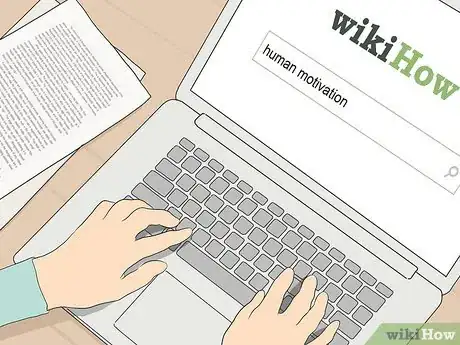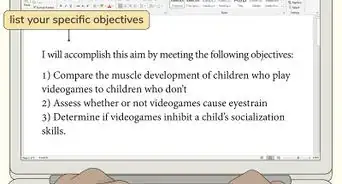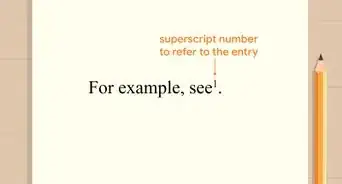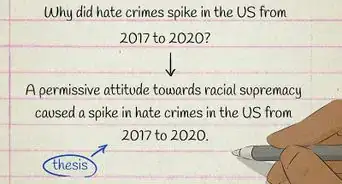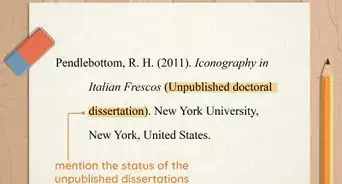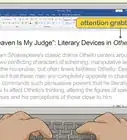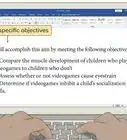This article was co-authored by wikiHow staff writer, Danielle Blinka, MA, MPA. Danielle Blinka is a Writer, Editor, Podcaster, Improv Performer, and Artist currently living in Houston, TX. She also has experience teaching English and writing to others. Danielle holds a Bachelor of Arts in English, Bachelor of Arts in Political Science, Master of Arts in English with a concentration in writing, and Master of Public Administration from Lamar University.
This article has been viewed 26,693 times.
Learn more...
Do you want to contribute original research and make an impact in your field? If so, it's important to look for research gaps, or areas of study that are either under-researched or currently unexplored. In this article, we'll explain in detail the best way to identify a research gap—by performing a comprehensive literature review—so you can dive deep into your research topic and analyze articles critically and effectively. For more tips and tricks on identifying potential research gaps and how to proceed when you find one, read on.
Steps
Researching Your Topic
-
1Start with a broad topic related to your field of interest. A broad topic allows you more opportunities to find a research gap. Pick a topic that interests you and that you already know something about. As you learn more about your topic, you can narrow it down further to help you find your focus.[1]
- If you start with a narrow topic, you may struggle to find a gap in research, since you’ll be focused on fewer avenues of study.
- For instance, a broad topic for social sciences research might be "organizational development" or "human motivation." For urban planning, a broad topic might be "walkable cities" or "traffic management."
-
2Conduct preliminary research to explore your topic. Begin with a simple online search to learn the basics of a topic. Read encyclopedia entries, journal articles, and recent news articles related to your topic. Then, search online databases for peer-reviewed journal articles related to your topic of study.[2]
- While you can't include sources like Wikipedia and news websites on your literature review, it's okay to read them to get an overview of your topic and recent developments in your field.
- It’s okay to narrow your topic as you learn more about it. However, keep your options open until you’re sure you’ve found an area with gaps in research.
- Let's say you were researching human motivation. You might use search terms like "motivating workers," "goal setting," and "improving worker productivity."
Advertisement -
3Compile a wide range of articles about your topic. Search for different types of articles, like informative texts, research texts, and meta-analyses. This will provide you a broader understanding of your topic so you can more easily find a gap. Save a digital copy of the articles you find to a Google drive or a USB drive. If you prefer, print out a hard copy of each article so you can easily write notes in the margins.[3]
- Your research needs to be very thorough to ensure that you’re actually finding a gap. If you only read a handful of articles, you may be missing other existing research that answers your proposed research question.
Tip: Look for both quantitative and qualitative research, if applicable to your field. This will give you a broader overview of the current research.
-
4Talk to an adviser or mentor about the current research in your field. If you’re working with an adviser or mentor, they’re a great asset for identifying your research gap. Ask them about current research and areas where they suspect you might find a gap. Additionally, check with them before you narrow your focus to a particular area of study to find out if they think it’s a good idea.[4]
- Ask them questions like, “Which areas of research are hot right now?” “What kinds of changes are happening within the field?” “What possible avenues of research do you see?” or “Do you think this topic is a good fit for me?”
Analyzing the Literature
-
1Read each article at least twice to help you understand it. It’s best to read each article multiple times so you fully understand what the author is saying. If you can, read each article aloud to help further your comprehension. As you read, identify the author’s purpose, their methods, and the results of their research.[5]
- If you decide an article is unhelpful, it’s okay to skip the second reading.
Tip: Conducting a literature review is often a very time-consuming task. However, it’s also an essential part of identifying a research gap. Additionally, you can use the notes you take during your literature review when it comes time to write your article, thesis, or dissertation.
-
2Check the introduction to learn why the research is important. Typically, the author will tell you in the introduction what their gap in research is, what research question they’re trying to answer, and how their findings fit into the current research. This can help you understand why the article is important and how it might relate to your own research. Keep the author’s statements in mind as you read through the article to see if they fulfilled their promises.[6]
- As an example, an author might identify their gap in research with a statement like: “This subject has not been previously studied,” or “This question remains unanswered.”
-
3Write notes and questions about the article as you read. It’s easy to forget what you’ve read and the questions that came to mind while you were reading, especially during a literature review. To help you keep track, jot down a short summary of important paragraphs, ideas that come to mind, and unanswered questions you have. Either write them in the margins of the article or keep track of them in a notebook.[7]
- If you keep your notes in a separate document, make sure you label them with the title of the article and the author’s name. This way you won’t accidentally get your notes mixed up.
-
4Look for the answers to your questions about the literature. If you have a question, read the article thoroughly to see if it’s answered. If you don’t find an answer, conduct further research to help you find an answer. Unanswered questions may highlight a gap in the current research.[8]
- Save any questions that you can’t answer because they may be a starting point for writing a research question.
-
5Map out the existing research using a table, Venn diagram, or mind map. While this is optional, creating a chart or table may help you better understand the literature. Additionally, it could help you identify common themes and areas that are under-developed. This might help you find a research gap.[9]
- For instance, you might make a research gap table in a spreadsheet. Create 3 columns and label them “Author,” “Year,” and "Summary." For each article, list the authors, year of publication, and a bullet point summary of the article contents.
- Similarly, you may make a Venn diagram to compare 1 or more articles. Look for overlapping themes and methods, as well as differences between the articles.
Using Current Research, Key Concepts, or Trends
-
1Check the “discussion” and “future research” sections for gaps. After the author explains their methods and results, they’ll typically explain their conclusions in a discussion section. This section helps you understand how the author’s ideas contributed to your field of study and how they might change the course of research. Furthermore, the “future research” section will point out any gaps in research that the author identified.[10]
- Keep in mind that other researchers may have addressed the gaps identified in a particular article since that article was written. However, this can give you a starting point for finding a potential gap.
-
2Read meta-analyses, literature reviews, and systematic reviews to identify trends. A meta-analysis is a comprehensive study that examines prior research and draws conclusions. Similarly, you can find literature reviews and systematic research reviews prepared by other scholars to help you get an overall sense of existing research in your field. Reading these types of documents can provide you an overview of the literature to save you time.[11]
- Don’t rely solely on these types of papers when conducting your research. However, they can make a great supplement.
-
3Review the key concepts listed on journal websites to find hot topics. Most major journals list out key concepts that are currently important to the field. This can help you narrow your literature review to topics that are currently being studied. Look over these lists and use them to narrow your interests to a current hot topic.
- Some journals will even tell you how many articles are pertaining to that key concept. If you see a key concept that has fewer articles than the others, that might be a good avenue for further research because it’s been studied less.
-
4Review Google trends to find questions asked about your topic. Google trends can tell you the types of questions people are asking about your topic. These questions could be a starting point for an effective research question. Compile a list of trending questions that sound interesting to you, then see if you can find the answers. A question that isn’t answered by current research could be a research gap.[12]
- You can access Google trends here: https://trends.google.com/trends/?geo=US
- For instance, if you look up "organizational development" on Google trends, you'll see that people are looking for information on management development, mission statements, and software framework.
Tip
- Reading Wikipedia articles related to your topic of study may help you identify a gap in research, though you can’t use those articles as sources. Look for areas where more citations are needed, unanswered questions, or sections that are underdeveloped.
References
- ↑ https://libanswers.snhu.edu/faq/264001
- ↑ https://libanswers.snhu.edu/faq/264001
- ↑ https://resources.nu.edu/researchprocess/literaturegap
- ↑ https://guides.umd.umich.edu/c.php?g=529423&p=3621573
- ↑ https://guides.umd.umich.edu/c.php?g=529423&p=3621573
- ↑ https://guides.umd.umich.edu/c.php?g=529423&p=3621573
- ↑ https://sites.temple.edu/article/2020/11/14/how-to-identify-the-research-gap/
- ↑ https://guides.umd.umich.edu/c.php?g=529423&p=3621573
- ↑ https://resources.nu.edu/researchprocess/literaturegap
